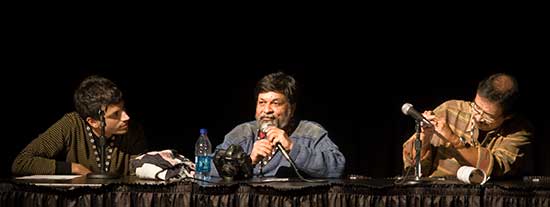BitDepth 652 - November 04
03/11/08 21:59 Filed in: BitDepth - November 2008
Alejandro Chaskielberg and three other photographers get the nod for the National Geographic All Roads Project Awards for 2008.
All roads lead home

Alejandro Chaskielberg, Shahidul Alam and Larry McNeil at PhotoPlus Expo, 2008. Photograph by Mark Lyndersay.
It was the closing day of PhotoPlus Expo in New York, and I was late for what would turn out to be one of the most interesting talks of the three-day exposition for a photographer from the developing world.
Culture on the Edge: Indigenous & Underrepresented Photography was supposed to feature the four winners of this year's All Roads Photography Program; Alejandro Chaskielberg (Argentina), Rena Effendi (Azerbaijan), Khaled Hasan and Farzana Wahidy (Afghanistan).
Of the four, only Chaskielberg would eventually take the stage (visa issues and work claimed the others), but he was well supported by Shahidul Alam, the legendary founder of the India's Drik photo agency and an aggressive supporter of indigenous photographic points of view and Larry McNeil, a 2006 award winner.
The All Roads Photography Program is an enterprise of National Geographic that reverses of the traditional flow of information and perspectives of developing nations and their cultures.
The anti-Geographic
All Roads is, essentially, the anti-Geographic, views of countries as seen by the people who are indigenous to them. The presentations at PhotoPlus suggest that the perspectives of those who live in a place are decidedly different from those who visit, even for the extended tours that are Geographic's specialty.
Larry McNeil's presentation offered a whimsical look at native American relations with the Europeans who would eventually conquer America.
Among the thorns in McNeil's psyche are the documentary photographer Edward Curtis and the Lone Ranger's simple buddy Tonto, who are subverted through his irrepressible wit into a bumbling imagemaker and an intellectual giant, respectively.
Alejandro Chaskielberg's work, The High Tide: Native Islanders and the
Community of the Paraná River Delta, is an intimidatingly complex look at the inhabitants of the lower delta of Argentina's Paraná-Plata basin, site of the region's first modern settlements.
Moonlight, long exposures
 These people's lives are tied to the river and Chaskielberg explores their existence with long exposures at night, careful setups that are shot with a large format film camera and require his subjects to remain still for up to ten minutes while he records moonlit images that he walks through, painting the image with additional light from handheld strobes and flashlights.
These people's lives are tied to the river and Chaskielberg explores their existence with long exposures at night, careful setups that are shot with a large format film camera and require his subjects to remain still for up to ten minutes while he records moonlit images that he walks through, painting the image with additional light from handheld strobes and flashlights.
Chaskielberg's halting English was hard to follow, but his All Roads essay on his chosen subject includes the following, "... I set up scenes with local inhabitants and Paraguayan immigrants to show a new culture that has formed in these islands—a culture with its own laws and codes, a by-product of unemployment and the immigration, in this estuary that is unique in the world, with a dense forest full of water and silence."
The photographs rarely have dark skies, and the lighting is both theatrical and surreal. The images include one of two young men on a pontoon laden with logs navigating down a river and another of a man with what looks like a half-ton of cut log on his back are as far from the rulebook of National Geographic as you can imagine.
Links
The All Roads Photography Program
Alejandro Chaskielberg's blog
Shahidul Alam's blog

Alejandro Chaskielberg, Shahidul Alam and Larry McNeil at PhotoPlus Expo, 2008. Photograph by Mark Lyndersay.
It was the closing day of PhotoPlus Expo in New York, and I was late for what would turn out to be one of the most interesting talks of the three-day exposition for a photographer from the developing world.
Culture on the Edge: Indigenous & Underrepresented Photography was supposed to feature the four winners of this year's All Roads Photography Program; Alejandro Chaskielberg (Argentina), Rena Effendi (Azerbaijan), Khaled Hasan and Farzana Wahidy (Afghanistan).
Of the four, only Chaskielberg would eventually take the stage (visa issues and work claimed the others), but he was well supported by Shahidul Alam, the legendary founder of the India's Drik photo agency and an aggressive supporter of indigenous photographic points of view and Larry McNeil, a 2006 award winner.
The All Roads Photography Program is an enterprise of National Geographic that reverses of the traditional flow of information and perspectives of developing nations and their cultures.
The anti-Geographic
All Roads is, essentially, the anti-Geographic, views of countries as seen by the people who are indigenous to them. The presentations at PhotoPlus suggest that the perspectives of those who live in a place are decidedly different from those who visit, even for the extended tours that are Geographic's specialty.
Larry McNeil's presentation offered a whimsical look at native American relations with the Europeans who would eventually conquer America.
Among the thorns in McNeil's psyche are the documentary photographer Edward Curtis and the Lone Ranger's simple buddy Tonto, who are subverted through his irrepressible wit into a bumbling imagemaker and an intellectual giant, respectively.
Alejandro Chaskielberg's work, The High Tide: Native Islanders and the
Community of the Paraná River Delta, is an intimidatingly complex look at the inhabitants of the lower delta of Argentina's Paraná-Plata basin, site of the region's first modern settlements.
Moonlight, long exposures

Chaskielberg's halting English was hard to follow, but his All Roads essay on his chosen subject includes the following, "... I set up scenes with local inhabitants and Paraguayan immigrants to show a new culture that has formed in these islands—a culture with its own laws and codes, a by-product of unemployment and the immigration, in this estuary that is unique in the world, with a dense forest full of water and silence."
The photographs rarely have dark skies, and the lighting is both theatrical and surreal. The images include one of two young men on a pontoon laden with logs navigating down a river and another of a man with what looks like a half-ton of cut log on his back are as far from the rulebook of National Geographic as you can imagine.
Links
The All Roads Photography Program
Alejandro Chaskielberg's blog
Shahidul Alam's blog
blog comments powered by Disqus

